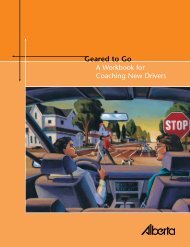Commercial driver's guide to operation, safety and licensing
Commercial driver's guide to operation, safety and licensing
Commercial driver's guide to operation, safety and licensing
You also want an ePaper? Increase the reach of your titles
YUMPU automatically turns print PDFs into web optimized ePapers that Google loves.
• Back off the accelera<strong>to</strong>r when going<br />
over the <strong>to</strong>p of a hill <strong>and</strong> let gravity <strong>and</strong><br />
momentum do the work.<br />
• Use cruise control where appropriate.<br />
• Reduce your average speed -<br />
driving fast eats up fuel no matter<br />
what you drive.<br />
• Change gears smoothly - shifting<br />
professionally will result in about 30%<br />
improvement in operating costs.<br />
• Always use the clutch, failure <strong>to</strong> do so<br />
can wear the gear teeth down in the<br />
transmission.<br />
• Practice progressive gear shifting at<br />
approximately 1600 rpm. Shifting before<br />
you reach the maximum governed rpm<br />
reduces equipment wear, decreases<br />
noise levels <strong>and</strong> saves fuel.<br />
• Run the engine in the highest gear<br />
range <strong>to</strong> keep it in a low rev range.<br />
• Use your retarder properly <strong>and</strong> turn it off<br />
when you do not need it - let the terrain<br />
work for you.<br />
Idling<br />
Idling a truck engine burns up <strong>to</strong> four<br />
litres of fuel per hour at 900 rpm. Turn<br />
off your engine when you s<strong>to</strong>p for any<br />
length of time - you will save fuel, reduce<br />
maintenance requirements, prolong engine<br />
life <strong>and</strong> prevent unnecessary emissions.<br />
If a 10-truck fleet were <strong>to</strong> cut idling by<br />
an hour a day for 260 days, it would<br />
save approximately 10,400 litres of fuel<br />
($11,440 at $1.10 per litre). A 100-truck<br />
fleet would save $114,400 <strong>and</strong> a 500-truck<br />
fleet $572,000.<br />
Taking advantage of<br />
technology<br />
New engine designs offer great benefits,<br />
delivering more horsepower <strong>and</strong> <strong>to</strong>rque<br />
in lower rpm ranges. You can downshift<br />
at about 1200 rpm <strong>and</strong> up-shift at about<br />
1600 rpm - rather than 2000 rpm.<br />
You shift less, save money, <strong>and</strong><br />
generate fewer emissions.<br />
Keeping up with road<br />
conditions<br />
Smart, fuel-efficient driving is also safe<br />
driving. Different road <strong>and</strong> traffic conditions<br />
present different challenges. As a driver,<br />
it’s important for you <strong>to</strong> keep the following<br />
in mind:<br />
• Light: Adjust your driving based on<br />
visibility. Wear sunglasses in bright<br />
conditions <strong>and</strong> reduce speed in poor<br />
light conditions.<br />
• Posture: Keep your seat adjusted <strong>to</strong> the<br />
correct position for comfort, alertness,<br />
visibility <strong>and</strong> access <strong>to</strong> controls.<br />
• Traffic: Try <strong>to</strong> travel at the same speed<br />
as other traffic, staying within the speed<br />
limit. Be considerate <strong>and</strong> give way <strong>to</strong><br />
other drivers.<br />
Street smart<br />
Managing your road speed with smart<br />
driving techniques allows you <strong>to</strong> keep your<br />
speed more constant <strong>and</strong> increase fuel<br />
efficiency. Generally, for every 10 km/h<br />
over 90km/h you use 10% more fuel.<br />
CHAPTER ELEVEN<br />
Fueling <strong>and</strong> Fuel Efficiency 93




